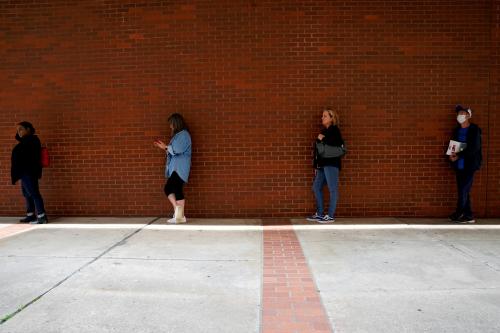If you want more content like this, subscribe to our newsletter.
This week in Class Notes:
-
- The digital divide—the correlation between income and home internet access —explains much of the inequality we observe in people’s ability to self-isolate.
- The labor force participation rate among older Americans and the age at which they claim Social Security retirement benefits have risen in recent years.
- Higher minimum wages lead to a greater prevalence of subminimum wage payment, though strong enforcement regimes can mediate this effect.
- A VOX chart shows which industries are most vulnerable to layoffs during COVID-19.
- The Washington Post Editorial Board discusses approaches to combating food insecurity brought on by COVID-19.
- Finally, check out Jonathan Rothwell’s new piece on the misleading nature of unemployment figures during this pandemic.
Social distancing, internet access and inequality
Access to high-speed internet plays a crucial role in an individual’s ability to self-isolate during a pandemic. Using data that tracks 20 million mobile devices and their movements across physical locations, Chiou et al. show that unequal access to high-speed internet explains much of the observed correlation between income and ability to stay home. The authors also examine compliance with state-level directives to avoid leaving your home. Devices in areas with either high-income or high-speed internet are less likely to leave their homes after such a directive. However, the combination of having both high income and high-speed internet appears to be the biggest driver of likelihood to stay at home. The latter finding suggests that the correlation between income and home internet access explains much of the inequality in people’s ability to self-isolate.
Employment at older ages and Social Security benefit claiming
A retired worker’s Social Security benefit partially depends on the age at which she claims benefits. Working longer and claiming benefits later can boost the monthly check. Patrick Purcell highlights several important trends in labor force participation among older Americans and the age at which people claim retirement benefits. Both the labor force participation rate among older Americans and the age at which they claim Social Security retirement benefits have risen in recent years. The proportion of fully insured men and women who claim retirement benefits at the earliest eligibility age of 62 has also declined substantially since 2000.
Understanding ‘wage theft’: Evasion and avoidance responses to minimum wage increases
Understanding employer compliance with minimum wage regulation is crucial for assessing labor market effects. Clemens et al. investigate how minimum wage increases and the strength of enforcement affect the prevalence of subminimum wage payment. The authors find strong evidence that higher minimum wages lead to a greater prevalence of subminimum wage payment—between 14% and 22% of realized wage gains. However, strong enforcement regimes appear to partially offset this effect by decreasing the baseline rate of subminimum wage payment and mediating the response to minimum wage increases.
Top chart
COVID-19 has brought with it an economic crisis, though not all Americans are being affected equally. This week’s top chart shows low-wage workers are particularly vulnerable to layoffs during this time, especially those who work in food or retail.

Choice opinion
“Congress has taken some steps to adapt benefits for the coronavirus crisis, including temporarily suspending the three-month time limit on SNAP benefits for unemployed adults without minor children. In the next COVID-19 relief bill, Congress should tie this suspension to economic indicators, rather than the public health emergency, since the economic downturn may well outlast the pandemic. Congress should also boost SNAP benefits…Even during this economic and public health crisis, the United States makes more than enough food to feed all its residents. Getting as much of it as possible to those in need is a challenge, but one that can be met with swift and creative action” writes the Washington Post Editorial Board.
Self-promotion
Nearly 30% of American workers have been laid off or seen a reduction in hours due to COVID-19. However, as Jonathan Rothwell explains in his new piece “Official jobless figures will miss the economic pain of the pandemic”, the magnitude of these losses is unlikely to be reflected in the headline numbers from our federal agencies. In order to understand whether interventions like the CARES Act stabilize employment relationships and benefits, Rothwell argues, we will need to consider new measures of unemployment—including those published by the Bureau of Labor Statistics with appropriate adjustments—that are better tailored to this unique pandemic.







Commentary
Class Notes: Unequal internet access, employment at older ages, and more
Wednesday, April 22, 2020